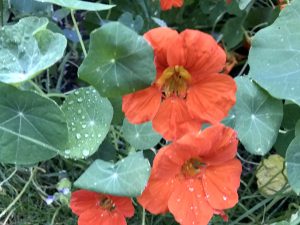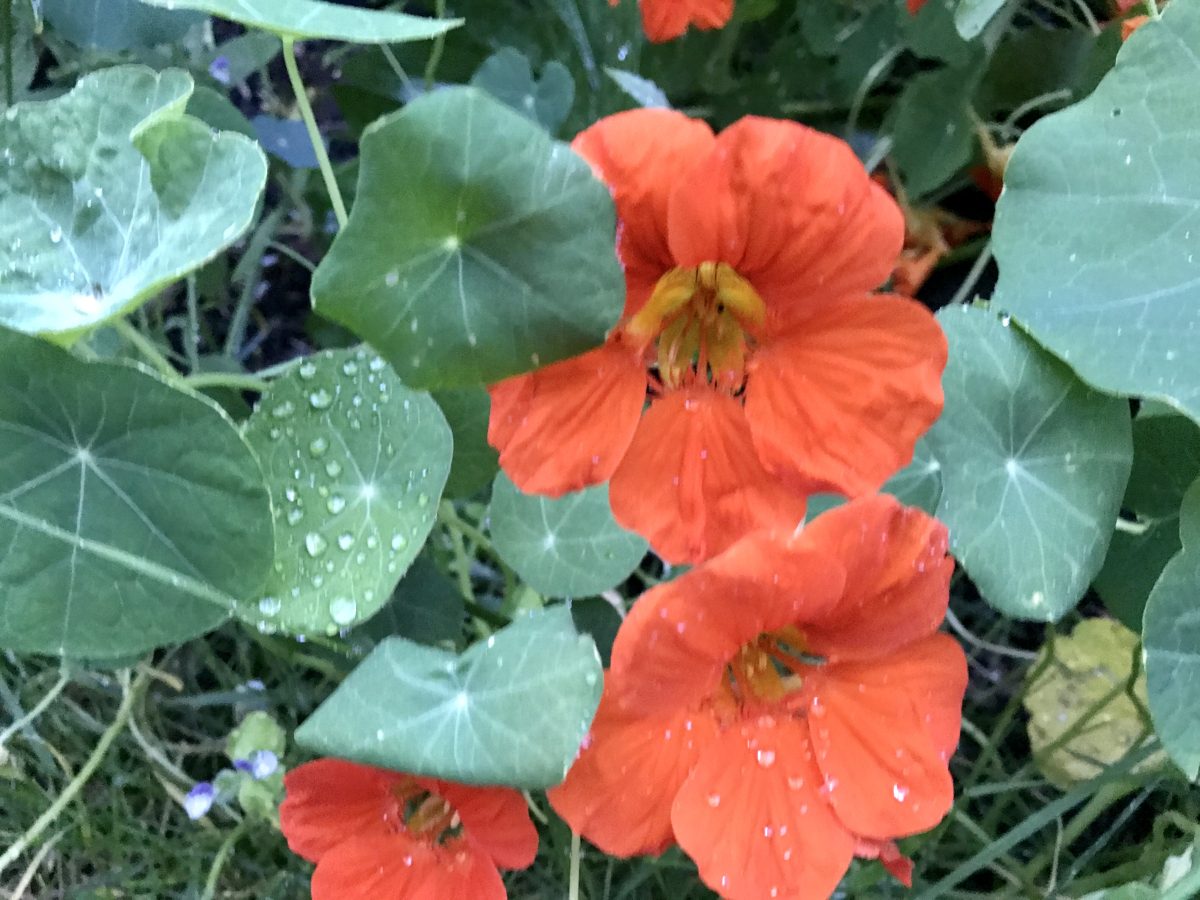
Gardening podcast nasturtium - Nasturtium mission creep
Season 3: Episode 6Gardening Podcast nasturtium. Penny's Nasturtiums are unruly and riddled with black fly.
Gardening podcast nasturtium - Transcription
Ah, the thunderous sound of the hosepipe slapping the dry soil. Ah, much needed after a day of 30 degrees. Oh, my word. I tell you what, I wasn't expecting that. We've had the weirdest weather, and I don't mean dramatic or challenging as it is in many parts of the globe. I just mean boring. It's been mono weather, like 20 degrees, 18, 19, oh, 22 degrees Celsius. Oh, back down to 15. When? Mid-July. You know, we're in summer in Britain, and yet the weather in the Northwest has not really kept up with the calendar.
So today has been a bit of a turnaround the last couple of days, actually. The heat has been building. What happens in the northwest of England is the heat builds. It gets what we call "dead muggy." That's true, dead muggy. It's too hot for me, right? At about probably 24 degrees. But it's been 30, 31 today. It gets dead muggy over the course of about three days, and then it chucks it down for another three days just to clear the air. And then we start all over again.
So the best equipment you can bring to the Northwest, and we're talking Manchester, Liverpool, Warrington, and beyond, is in the height of summer, a cardigan in case it gets a bit nippy and an umbrella in case it rains. So that's the two bits of main kit you'll need in a Northwest summer.
But we're very lucky. The light is with us from right 4 o'clock in the morning all the way through till half 11 at night, sort of thing, on a clear day. And it has been super warm today, so the flowers, the garden needs a bit of attention and watering.
And what I love about watering late at night is that the plants really soak up the moisture.
There's nothing squandered. It's really valuable to the plant. It doesn't evaporate. It goes straight to really thirsty roots and leaves. I can already begin to see some of the sunflowers we've planted at the back of the Jasper Memorial bed. That's the dead cat, basically, if you haven't listened before. At the back of the Jasper Memorial bed, they are instantly perked up from a bit of hosepipe work, which is really pleasing.
So everything's really thirsty and ready to absorb, and what you get to do is you do it plant by plant. You know, you hit the roots with the hosepipe. You're giving it really good attention, and you're looking at each plant and maybe deadheading. Or, as I saw on these nasturtiums, which are at the front of the bed, they are riddled with black fly, riddled, and I don't want to spray them because there are so many of them and I'm, you know, chemical averse.
My nasturtiums are covered in black fly
So what I've done with a few of the heavily damaged ones basically is taken the stalk where it's got a new flower head on it. And of course, it's the new juicy tender leaves and buds that the flies go to because it's easier to nibble into, isn't it?
So I'm just going to change the setting on this hosepipe because I'd rather think, "Oh, hello, it's a little noisy." Is that better? Oh, I'm just going to give it a light shower. There we go. All right.
So, um, the new growth is where the flies go to because it's easier to nibble into, isn't it?
Pulling the black fly off with your fingers
So what I do is gently pull the black fly off through the thumb and forefinger movement on the old stalk and just get rid of it. Oh, it's gross but very pleasing at the same time. Insects are good for other animals to live on, as we know. However, you don't want them all over your garden, do you? Just a few.
Nasturtiums mission creep
The nasturtiums, actually, have a bit of mission creep going on. Frankly, they're overplaying their part, and bless them, they've taken over the bed. Essentially, what I'm going to do in a few days' time, before they start seeding and dying off, is clear them. Last year, there were only a few of them, but they self-seeded and really ran away with themselves.
So these guys are taking over the bed, which is okay because they're beautiful and they're right at the front, filling all the gaps and looking very jolly in orange, green, and yellow at the top there. You know, I believe I should put them in a salad. Go on, I'm going to have one. Is it black fly-free? Yes.
You can eat Nasturtiums in a salad
So they look jolly, but I don't want them doing the same again and doubling up. Now, this is the moment of truth. I really want this hosepipe to stop, but the trigger isn't working. It's completely ruined. Anyway, I'll put that aside. Let's have a look at this. Let's have a little taste. Okay, so I grew up being told not to eat plants because they might be poisonous, so eating them goes against everything in my body.
Right now, every cell is saying, "No, you're going to die if you eat that." So here we go, live on air, well, podcast. Let's have one more. Hmm, it's quite velvety. There's a velvety kind of texture to it, so it's not smooth, particularly. It kind of sticks to your tongue. Yeah, you can taste the garden, like soil and plants and leaves.
It tastes a little like rocket
Oh, hang on. Oh no, it's quite peppery. Hmm, like rocket leaves would be peppery on the aftertaste. Hmm, I still think it's showing off to put them in a salad.
I'm sorry, I know I've had advice from a podcast listener. Bless her, but I just think it's showing off, putting it in a salad. Oh, look, fresh green leaves from the garden.
Right, let's carry on. Now, the Jasper Memorial bed is about 6 meters long and just a couple of meters deep, and it's weird because Jasper's buried there. It's actually prolific in the growth and success of the plants in there.
So we've got cosmos, a few sunflowers, gladioli, and that thing I can never remember the name of. I'm gonna say flocks, but I'm not entirely convinced. And then there's salvia at the back and a hosta, which is holding off from the snail attacks quite easily, I think. All doing brilliantly.
And then you move beyond the middle, the center point, which is the Acer. Quite a small Acer. Come on, grow a little. Please just grow. It's not really done its job recently.
I was thinking, when a plant doesn't grow, it's fine. It's just doing some thinking, putting down some roots, having some quiet time. And maybe next year it's gonna really come on. Anyway, hold out hope for that.
So again, beyond the Acer, the stunted growth Acer, we're coming towards the back end of the bed, away from the house. And I don't know what's up with this patch where we've created new beds from old lawn areas. There isn't any quality control, basically. There's no uniformity in the quality of the soil. So you go through these belts of brilliant soil where Jasper's buried, and then into really unfriendly soil where plants don't flourish or thrive.
They need a lot of feeding and watering. I don't know why that is. Well, it's the soil, isn't it? Basically, it's your basic soil problem. There's probably a gardening term for that that the experts know about. But you didn't come here for that, did you? No. Good, right.
So we've come to the end of the bed. We've come to the end of the watering job for the evening. All the plants are very grateful, I feel. The nasturtiums that I've pulled out so far, which were overtaking the hydrangea, are now on the floor. And Joey has run off with them. And I think he's just dropped one, actually, because he's probably got that peppery aftertaste in his mouth. Anyway, onwards. I'll see you soon.
How do you grow nasturtiums?
Choose a suitable location: Nasturtiums prefer full sun but can tolerate partial shade. Ensure the area has well-draining soil.
Sow the seeds: You can start nasturtiums from seeds directly in the garden bed after the danger of frost has passed. Alternatively, you can start them indoors 4-6 weeks before the last frost date and transplant them outside when the weather is favorable.
Prepare the soil: Nasturtiums are not very demanding and can grow well in average soil. However, if the soil is poor, you can enrich it by adding compost or well-rotted manure to improve fertility.
Sow the seeds: Plant the seeds about 1 inch deep and space them 8-12 inches apart. Cover the seeds with soil and water gently.
Watering: Keep the soil consistently moist but not waterlogged. Nasturtiums don't require excessive watering and can tolerate some drought.
Provide support (optional): Nasturtiums are trailing plants that can spread and cover a large area. If desired, you can provide support such as trellises or stakes for them to climb.
Fertilization: Nasturtiums are relatively low-maintenance and don't require much fertilization. If needed, you can apply a balanced fertilizer sparingly once or twice during the growing season.
Pests and diseases: Nasturtiums are generally resistant to pests and diseases. However, they can attract aphids. If aphids appear, you can wash them off with a strong spray of water or use organic insecticidal soap.
Harvesting: Nasturtiums produce vibrant and edible flowers and leaves. You can harvest the flowers and leaves as they mature and use them in salads, garnishes, or as a colorful addition to dishes.
